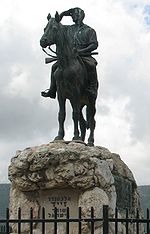Rabin Pre-Military Academy
The Rabin Pre-Military Academy (full name: המכינה הקדם-צבאית להכשרת מנהיגות חברתית ע"ש יצחק רבין; HaMekhina HaKdam-Tzva'it LeHakhsharat Manhigut Hevratit Al Shem Yitzhak Rabin—The Pre-army Preparatory Program for Training Social Leadership, named for Yitzhak Rabin) is a secular mechinah for high-school graduates in Israel, located at the Oranim College in the Western Galilee. Founded in 1998, the program features intensive studies in a range of subjects focusing on the sociopolitics of Israel, its history focusing on the pre-state pioneering settlers, Jewish studies, and humanistic-ideological aspects of current events, as well as personal development. The studies are combined with volunteer service in the public school system of outlying communities. The 10-month residential program defers compulsory military service in the framework of the post-secondary "year of service" (sh'nat sherut), after which its graduates are inducted into the Israel Defense Forces. The academy was founded and still directed by Danny Zamir who is a deputy battalion commander in the reserves.
Excerpt from the Wikipedia article Rabin Pre-Military Academy (License: CC BY-SA 3.0, Authors).Rabin Pre-Military Academy
7213, Kiryat Tivon
Geographical coordinates (GPS) Address Nearby Places Show on map
Geographical coordinates (GPS)
| Latitude | Longitude |
|---|---|
| N 32.7112 ° | E 35.1094 ° |
Address
קפטריה
7213
3658800 Kiryat Tivon
Haifa District, Israel
Open on Google Maps











